6 Peculiar Mother of Thousands Varieties [With Pictures]
The Bryophyllum is a fascinating plant with about 30 different types. It’s part of the thick-leaf family and belongs to the Kalanchoe genus. You’ll mostly find these plants growing naturally in Africa, but nowadays, people also love to have Bryophyllum plants in their living rooms.
One particular variety that stands out is the mother of thousands. These plants are super tough and hardly ever get bothered by pesky pests.
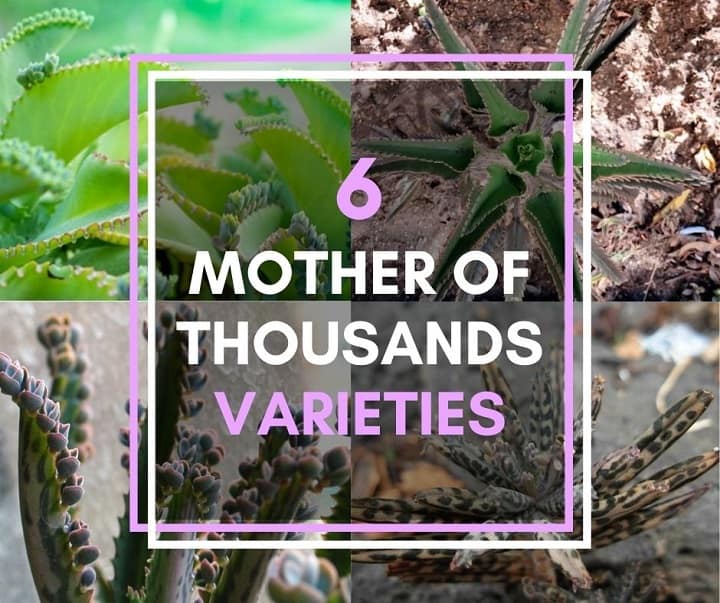
Contents
- 1 Mother of Thousands Varieties
- 1.1 Bryophyllum daigremontianum (Kalanchoe daigremontiana)
- 1.2 Bryophyllum delagoense (Kalanchoe delagoensis)
- 1.3 Bryophyllum fedtschenkoi (Kalanchoe fedtschenkoi)
- 1.4 Bryophyllum gastonis-bonnieri (Kalanchoe gastonis-bonnieri)
- 1.5 Bryophyllum х houghtonii (Kalanchoe х houghtonii)
- 1.6 Bryophyllum pinnatum (Kalanchoe pinnata)
- 2 Taking Care of Mother of Thousands
- 3 FAQs
- 4 Is the mother of thousands poisonous?
Mother of Thousands Varieties
The Mother of Thousands is an incredible plant that belongs to the Kalanchoe genus. It goes by many names, such as Palm Tree Bryophyllum, Mexican Hat Plant, Alligator Plant, Devil’s Backbone, Chandelier Plant, and Mother of Millions. Let’s explore some of the fascinating types of Mother of Thousands plants, each with its unique characteristics.
Bryophyllum daigremontianum (Kalanchoe daigremontiana)

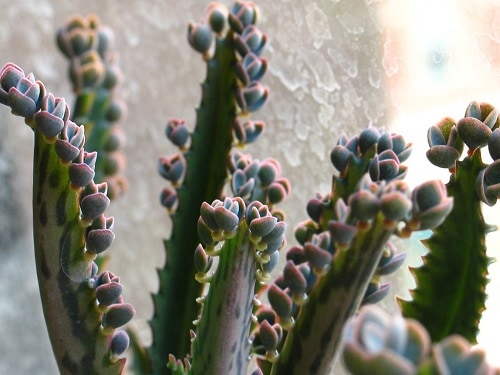
Let’s start with the Bryophyllum daigremontianum, also known as the Palm Tree Bryophyllum. It is a slender succulent herb that can grow up to 16 inches tall. The leaves are triangular and have a bluish-green color with brownish-black spots. The plant looks like a miniature palm tree, thanks to its bare stems and upper whorl of leaves. It’s a real survivor and rarely gets bothered by pests.
Bryophyllum delagoense (Kalanchoe delagoensis)
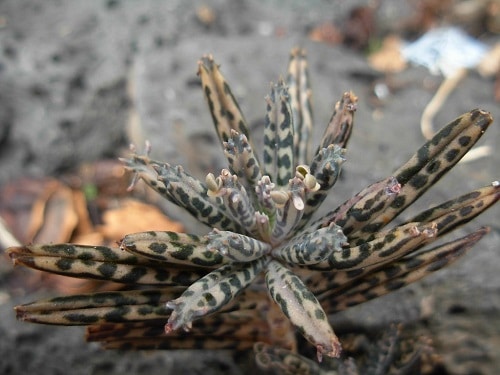
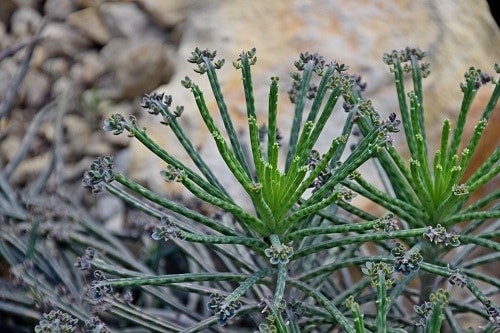
Next up is the Bryophyllum delagoense, also known as the Mother of Millions. This plant has a fascinating way of reproducing. It grows little plantlets on the ends of its leaves, which then drop off and grow into new plants. These plantlets can grow anywhere, even in between cacti or on a cement patio. They are quite hardy and can survive in various conditions. However, their ability to spread quickly has made them invasive in some areas.
Bryophyllum fedtschenkoi (Kalanchoe fedtschenkoi)
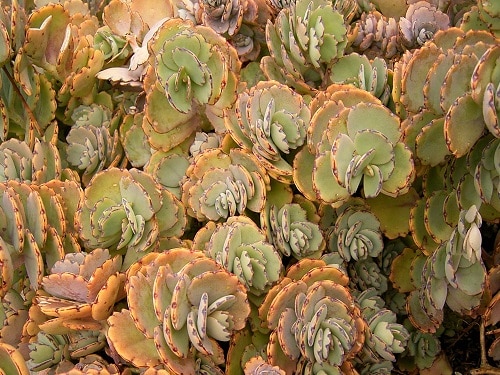
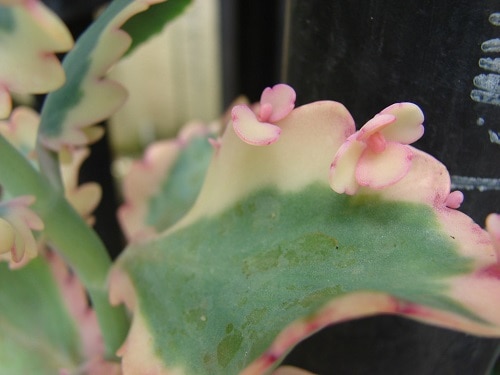
Another variety is the Bryophyllum fedtschenkoi, also called the South American air plant or Lavender Scallops. This plant has metallic green leaves that may turn pink or red under strong sunlight. It produces bell-shaped purple or reddish-brown flowers that hang in loose clusters. It’s a popular houseplant and can be grown indoors or in tropical gardens.
Bryophyllum gastonis-bonnieri (Kalanchoe gastonis-bonnieri)
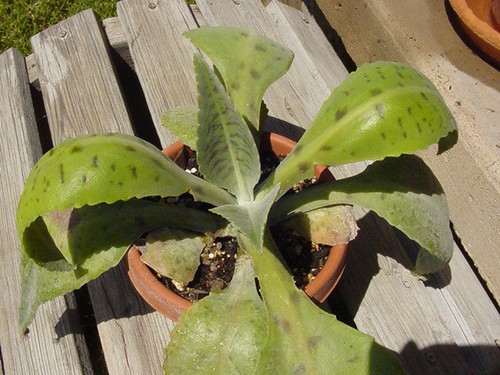
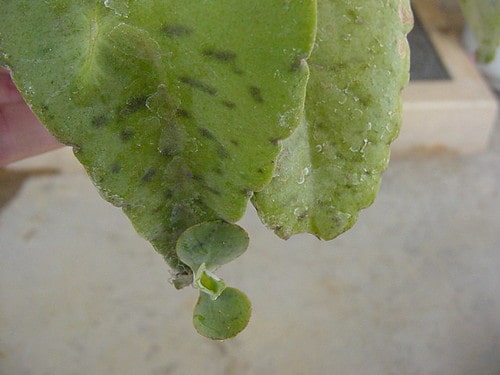
The Bryophyllum gastonis-bonnieri, also known as the Tree of Life, has large rosettes of purple-blotched light green foliage. It’s famous for its waxy red candelabras and is quite a sight to behold.
Bryophyllum х houghtonii (Kalanchoe х houghtonii)
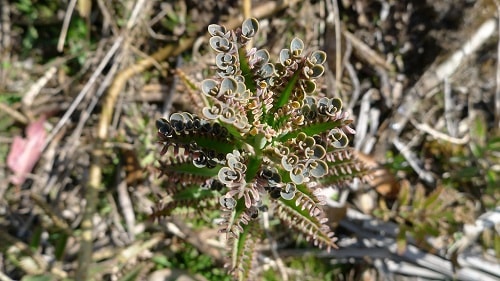
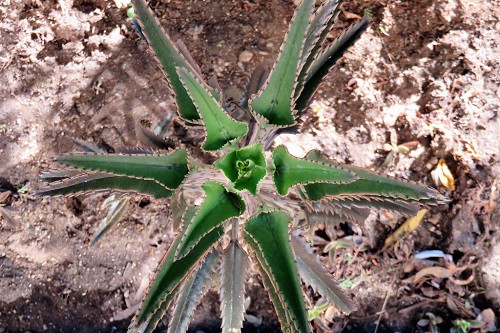
Next, we have the Bryophyllum х houghtonii, also called the Mother of Millions hybrid. This plant has V-shaped leaves and can grow up to 30 inches tall. It originated in Madagascar but is now cultivated in many tropical countries. It’s a hardy plant that spreads easily and can be challenging to get rid of. It’s important to note that all parts of the Mother of Thousands plant are poisonous to humans and livestock.
Bryophyllum pinnatum (Kalanchoe pinnata)
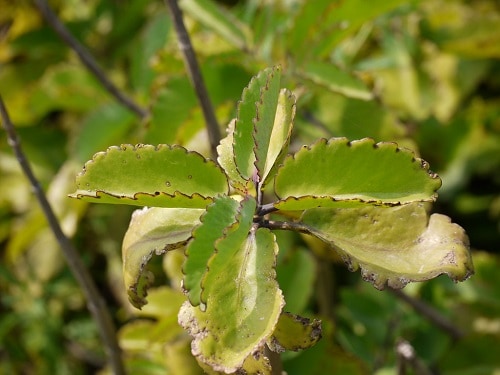

Finally, the Bryophyllum pinnatum, also known as the Life Plant or Miracle Leaf, is a remarkable succulent. It produces small plantlets along the edges of its leaves, even when detached from the main plant. These plantlets easily root and create new plants, making it a prolific species. The plant also displays bell-shaped blossoms, earning it the nickname “Cathedral Bells.” While it can be invasive, it provides an excellent opportunity for learning about plant propagation and adds beauty to any garden. Just remember to manage its growth to prevent excessive spreading.
Taking Care of Mother of Thousands
To ensure the optimal growth and health of your Mother of Thousands plant, it’s important to provide the right conditions and follow proper care practices.
Soil
Use a well-draining soil mix that is specifically formulated for succulents and cacti. You can also create your own by mixing equal parts of potting soil and sand.
Watering
Mother of Thousands stores water in its fleshy leaves, so it requires less frequent watering. During the summer months, water the plant once or twice a week, allowing the soil to dry out between waterings. In winter, reduce watering to once a week. It’s crucial to avoid overwatering, as it can lead to root rot. Water the plant thoroughly, and discard any excess water that collects in the saucer after a few minutes.
Light
Mother of Thousands thrives in bright, indirect light. Place it in a location where it can receive plenty of bright, filtered sunlight throughout the day. Avoid direct sunlight, especially during the midday hours, as it can scorch the leaves.
Fertilizer
While Mother of Thousands generally doesn’t require frequent fertilization, you can fertilize it during the summer months to promote better growth. Use a balanced liquid fertilizer specifically formulated for succulents and apply it once a month. Avoid fertilizing during winter, as the plant’s growth slows down.
Temperature and Humidity
Mother of Thousands prefers temperatures between 60°F and 75°F (15°C and 24°C). It can tolerate higher temperatures but may need extra protection from direct midday sun. Dry and hot air doesn’t affect the plant, but high humidity increases the chances of disease. Avoid placing the plant in areas with excessive humidity. It’s best suited for average indoor humidity levels.
Wintering
Mother of Thousands goes through a winter dormancy period. During this time, it benefits from cooler temperatures of around 50°F to 55°F (10°C to 13°C). This cooler environment promotes blooming in spring. Keep the plant away from heated rooms, as it can lead to leggy growth and hinder flower formation.
Pests and Diseases
Mother of Thousands is generally resistant to pests and diseases. However, overwatering or high humidity can make it susceptible to powdery mildew. If you notice white or gray spots on the plant or rolled leaves, treat it with a mild fungicide. Maintain proper ventilation and avoid overcrowding to prevent fungal issues. Springtails can occasionally appear but are mostly harmless. Control their population by placing the pot in a larger container filled with water; the springtails will float to the surface and can be removed.
Repotting and Pruning
Repot your Mother of Thousands when the roots start growing out of the drainage holes. The best time to repot is in early spring after its winter dormancy. Use a slightly larger pot with well-draining soil. Prune the plant to maintain its shape and to prevent dehydration. Use a sharp knife or a small saw to prune, and treat the cut surfaces with cinnamon to promote healing. The plant will quickly produce new shoots near the cut surface.
Propagation
Mother of Thousands has a unique method of propagation. It produces numerous plantlets along the edges of its leaves. You can easily remove these plantlets and pot them to grow new plants. Place the plantlets on moist soil in a sunny location. Keep the soil slightly moist, and roots will develop quickly. You can also propagate the plant using seeds or by taking side shoots. Regular pruning helps the plant grow bushier.
By following these care guidelines, you can ensure that your Mother of Thousands plant thrives and continues to amaze with its unique characteristics and growth habits.
FAQs
Is the mother of thousands poisonous?
Parts of the mother of thousands plant are poisonous if ingested. All members of Kalanchoe are toxic for livestock, birds and small animals, due to the presence of cardio-active glucosides. Based on North American studies using chickens, Kalanchoe fedtschenkoi, Kalanchoe daigremontiana, and Kalanchoe delagonensis were the most toxic; the toxic dose was 8–12g /kg b.w. (Williams and Smith 1984). Dogs are reported to be particularly sensitive to the cardiotoxic effects of Kalanchoe.
